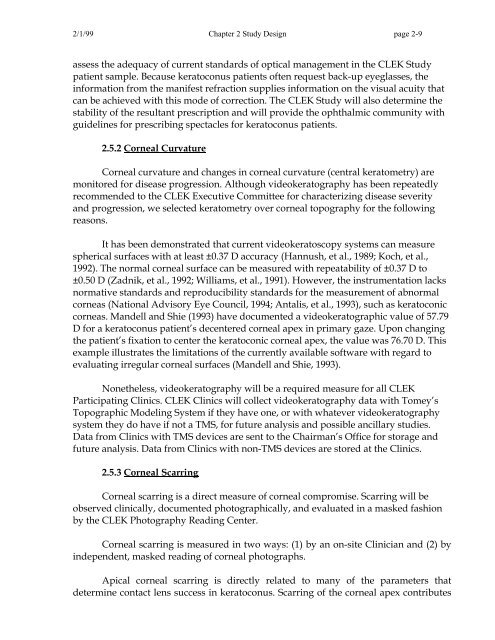OM t of c.iii - Vision Research Coordinating Center - Washington ...
OM t of c.iii - Vision Research Coordinating Center - Washington ...
OM t of c.iii - Vision Research Coordinating Center - Washington ...
You also want an ePaper? Increase the reach of your titles
YUMPU automatically turns print PDFs into web optimized ePapers that Google loves.
2/1/99 Chapter 2 Study Design page 2-9<br />
assess the adequacy <strong>of</strong> current standards <strong>of</strong> optical management in the CLEK Study<br />
patient sample. Because keratoconus patients <strong>of</strong>ten request back-up eyeglasses, the<br />
information from the manifest refraction supplies information on the visual acuity that<br />
can be achieved with this mode <strong>of</strong> correction. The CLEK Study will also determine the<br />
stability <strong>of</strong> the resultant prescription and will provide the ophthalmic community with<br />
guidelines for prescribing spectacles for keratoconus patients.<br />
2.5.2 Corneal Curvature<br />
Corneal curvature and changes in corneal curvature (central keratometry) are<br />
monitored for disease progression. Although videokeratography has been repeatedly<br />
recommended to the CLEK Executive Committee for characterizing disease severity<br />
and progression, we selected keratometry over corneal topography for the following<br />
reasons.<br />
It has been demonstrated that current videokeratoscopy systems can measure<br />
spherical surfaces with at least ±0.37 D accuracy (Hannush, et al., 1989; Koch, et al.,<br />
1992). The normal corneal surface can be measured with repeatability <strong>of</strong> ±0.37 D to<br />
±0.50 D (Zadnik, et al., 1992; Williams, et al., 1991). However, the instrumentation lacks<br />
normative standards and reproducibility standards for the measurement <strong>of</strong> abnormal<br />
corneas (National Advisory Eye Council, 1994; Antalis, et al., 1993), such as keratoconic<br />
corneas. Mandell and Shie (1993) have documented a videokeratographic value <strong>of</strong> 57.79<br />
D for a keratoconus patient’s decentered corneal apex in primary gaze. Upon changing<br />
the patient’s fixation to center the keratoconic corneal apex, the value was 76.70 D. This<br />
example illustrates the limitations <strong>of</strong> the currently available s<strong>of</strong>tware with regard to<br />
evaluating irregular corneal surfaces (Mandell and Shie, 1993).<br />
Nonetheless, videokeratography will be a required measure for all CLEK<br />
Participating Clinics. CLEK Clinics will collect videokeratography data with Tomey’s<br />
Topographic Modeling System if they have one, or with whatever videokeratography<br />
system they do have if not a TMS, for future analysis and possible ancillary studies.<br />
Data from Clinics with TMS devices are sent to the Chairman’s Office for storage and<br />
future analysis. Data from Clinics with non-TMS devices are stored at the Clinics.<br />
2.5.3 Corneal Scarring<br />
Corneal scarring is a direct measure <strong>of</strong> corneal compromise. Scarring will be<br />
observed clinically, documented photographically, and evaluated in a masked fashion<br />
by the CLEK Photography Reading <strong>Center</strong>.<br />
Corneal scarring is measured in two ways: (1) by an on-site Clinician and (2) by<br />
independent, masked reading <strong>of</strong> corneal photographs.<br />
Apical corneal scarring is directly related to many <strong>of</strong> the parameters that<br />
determine contact lens success in keratoconus. Scarring <strong>of</strong> the corneal apex contributes
















